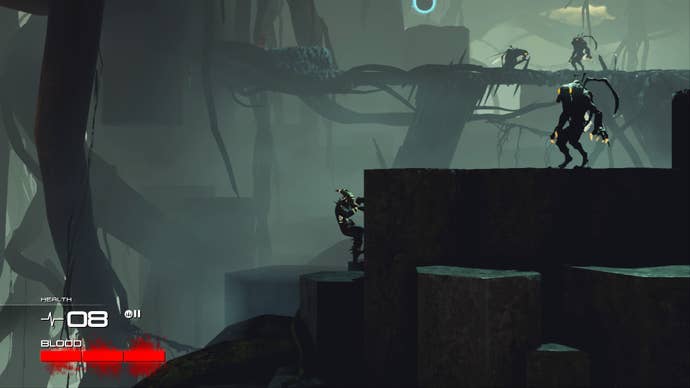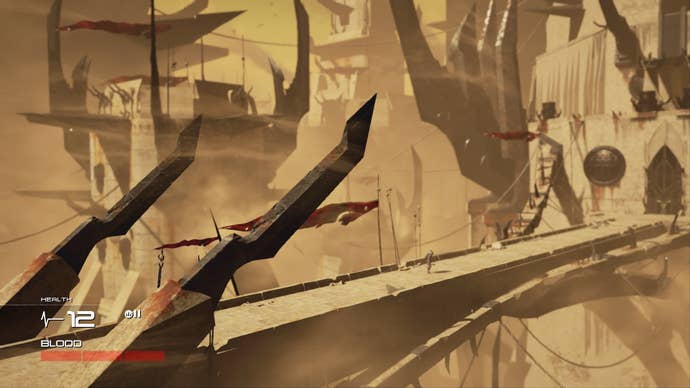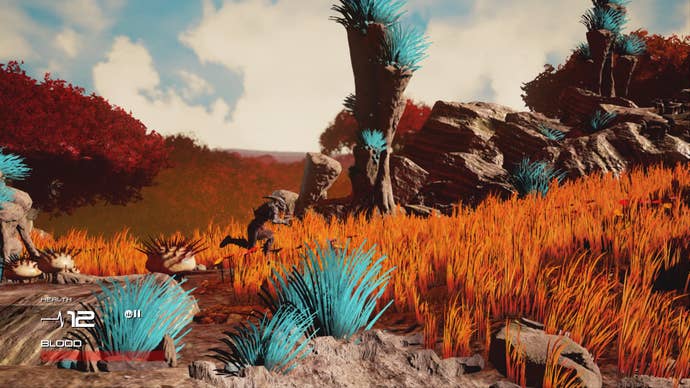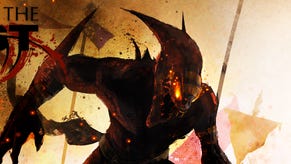Shadow of the Beast PS4 Review: Classic Platform Brawler
Psygnosis' 1989 Commodore Amiga classic gets reimagined for PlayStation 4 - and it's great!
This article first appeared on USgamer, a partner publication of VG247. Some content, such as this article, has been migrated to VG247 for posterity after USgamer's closure - but it has not been edited or further vetted by the VG247 team.
Psygnosis' Shadow of the Beast was quite the sensation when it launched on the Commodore Amiga back in 1989. At a time when 8-bit systems were still popular amongst the gaming mainstream, and the potential of 16-bit computers was still being explored, Shadow of the Beast's highly colorful graphics, large sprites, and up to twelve layers of parallax scrolling really pushed the boundaries of what was possible in gaming software at the time. What was also notable was its very high-quality music, which used sampled instruments to deliver a soundtrack that still stands up even today.

Despite having a high level of difficulty, the game was well received by critics, and became a "must have" item for Amiga owners, who used it to show off their machines' prowess. However, while it was launched exclusively on Amiga, it didn't take long for Shadow of the Beast to be ported to other systems, and over the next few years, versions of varying quality appeared on platforms as diverse as the Atari Lynx, ZX Spectrum, FM Towns, and SNES.
Now, 27 years since it first appeared, the game has been remade – or should that be re-imagined? – for the PlayStation 4 by Heavy Spectrum Entertainment Labs. However, although it bears the same name and follows a similar side-scrolling platforming format as its forebear, the modern Shadow of the Beast is essentially an all-new game, despite featuring a few nods to the original's plot and looks.
Its action is focused on the anti-hero Aarbron, an unfortunate individual who was kidnapped as a child and transformed by evil mage Maletoth into the beast to do his bidding. The proceedings begin with Aarbron on a leash, leading Maletoth as he fights his way into a castle so he can steal a newborn child from the residents therein. However, as Aarbron uses his spiked fists to murder the baby's protectors, the last one to fall momentarily reaches out to him, and Aarbron realizes that it's his father. He instantly recalls what happened to him – and he decides there and then to wreak revenge on Maletoth for his wrongdoing. So begins a journey of vengeance as Aarbron pursues Maletoth through seven large levels to confront him in an ultimate showdown.

The trek through Shadow of the Beast sees the player exploring a variety of different landscapes, from lush, verdant pastures through parched deserts to what seems like hell itself. Even though the action plays out in only two dimensions, all backgrounds are rendered in 3D, giving a fantastic sense of depth and scale. The quality of the graphics is top notch, and there are definite echoes of the original Amiga Shadow of the Beast in terms of some of the settings and use of color. Indeed, there are hints of Roger Dean everywhere. He created the original iconic box art, and the game's early areas feel like some of his paintings brought to life. It's a nice touch, and something that those who remember the original Amiga game will definitely notice and appreciate.
Shadow of the Beast's action is combat-heavy, and there are plenty of monsters to fight as you work your way towards your meeting with Maletoth. Things start out fairly straightforwardly, and it's possible to make progress by simply mashing the attack button to make short work of the armies of enemies sent to dispatch you. However, as you begin to delve deeper into the game, denizens become more deadly, and you have to start using the other moves in your repertoire to avoid taking a pasting. The most important of these is block, and mastering its sometimes-finicky timing is key to defeating tougher enemies. A well-placed block essentially opens up the enemy to attack, allowing you to kill it with ease. Fail to time your move correctly, however, and you'll inevitably get nailed, knocking a point off your ten-life total.

Along with a block move, you have a counter, stun, roll, grab and throw maneuver, and a limited-use rage attack. Like blocking, the timing of each move is critical, and it takes a while to learn the ins and outs of when to use each move, and where. However, once you’re up to speed on Aarbron's various abilities, fights become quite tense and interesting. Oftentimes, enemies attack in swarms called encounters, and your score during these is ranked. As you kill enemies, depending on which moves you use, you advance your score multiplier. In other words, the more style and finesse you display during an encounter, the more points you score, and the higher your rank when the encounter is tallied.
This is important because you're given an overall score based on how well you perform during each level, and there are global leaderboards that enable you to see how you stack up against other players. As well as your overall score being ranked, so is your time taken to finish a level. It's a neat idea, and one that adds an interesting competitive dimension to Shadow of the Beast. Indeed, the game seems to be built around replayability – even though I've completed its main campaign, I haven't seen everything Shadow of the Beast has to offer: Each level features hidden areas, secret encounters, and score-boosting items to find.

Another reason why scores are important is because after you finish a level, your total points earned are turned into currency that you can use to purchase upgrades for Aarbron – as well as other interesting items. There are useful game-improvers like talismans you can equip to give you perks, health boosts, and upgraded combo moves, as well as things like the ability to play the game with the original Amiga soundtrack, and an illustrated retrospective of the first release. However, for me, the most interesting item to buy was the ability to play an emulated version of the original Amiga Shadow of the Beast. It's been fun playing it again, although I'd forgotten just how damn hard it was. Fortunately, you can also buy a cheat that gives you unlimited lives. Needless to say, that was my second purchase.
Although I ended up enjoying my time with Shadow of the Beast, it didn't immediately grab me. Initially, combat felt somewhat rudimentary and dull. Then, when the action began to step up, and I realized I had to use Aarbron's combo moves, the game became frustrating. The timing of the different maneuvers is quite tight, and it takes a while to learn exactly when to use them to deliver the highest-scoring opportunities. The fighting itself isn't too difficult, and it is possible to breeze through most of the game using the most basic moves, but if you do care about your score, the proceedings become considerably more challenging. There's basically a cadence to the game that needs to be learned, and once you've mastered it, fights become a rhythmic battle of blocks, stuns, grabs, and executions, making the game rewarding and fun. Getting to that point isn't easy, however – although your mileage might vary, of course.

Alongside its combat, Shadow of the Beast offers basic platform puzzling and exploration. Levels are quite expansive, and offer opportunities to go off the beaten track to find hidden items. With some games, I don't really care about locating everything, but for some reason – probably something to do with its competitive leaderboards – Shadow of the Beast has drawn me back on numerous occasions to see if I can find what I'm missing. Part of its appeal is that while the platforming isn't particularly sophisticated, it's nicely designed to make exploration entertaining. I just had fun wandering around the landscapes and seeing what secrets they held.
Of course, Shadow of the Beast packs boss fights, and they're generally varied and interesting. They follow the traditional oldschool platforming format of finding and exploiting that boss' particular weakness, while blocking and dodging its attacks. While I didn't experience anything that felt particularly new or innovative, the fights are still enjoyable and entertaining. Indeed, that pretty much describes Shadow of the Beast overall. It's not a particularly original game, but it's executed very well to deliver a really worthwhile platforming experience that hearkens back to the original release's gameplay, while adding layers of depth in terms of its combat and leaderboards.
Ultimately, Shadow of the Beast is a slick and polished, oldschool-feeling beat 'em up platformer that's simply great fun to play – especially once you master its somewhat tricky combat combos. It looks superb, and features a solid soundtrack that suits the action perfectly. The main campaign doesn't take particularly long to finish, but the game gives you plenty of excuses to come back for more, especially if you're a fan of classic arcade platform action and enjoy finding hidden items and challenging leaderboard scores.
InterfaceWell presented overall, with interesting historical aspects to unlock, such as an emulated version of the original Amiga game, and concept art galleries.
Lasting AppealAlthough it only takes a few sessions to complete the campaign, there are plenty of secrets to find, unlockables to earn, and leaderboard scores to vie for.
SoundAn excellent orchestral soundtrack provides the perfect atmosphere for the game.
VisualsThe landscapes are beautifully rendered, with a tremendous feeling of depth.
ConclusionShadow of the Beast takes the original Commodore Amiga's platform-combat gameplay and brings it bang up to date with plenty of exploration, and a more sophisticated fighting system. The result is a thoroughly enjoyable platform game that features an interesting story, entertaining combat, and excellent audio-visuals. The main campaign doesn't take too long to beat, but the game packs enough secrets and unlockables to keep you coming back for more.












